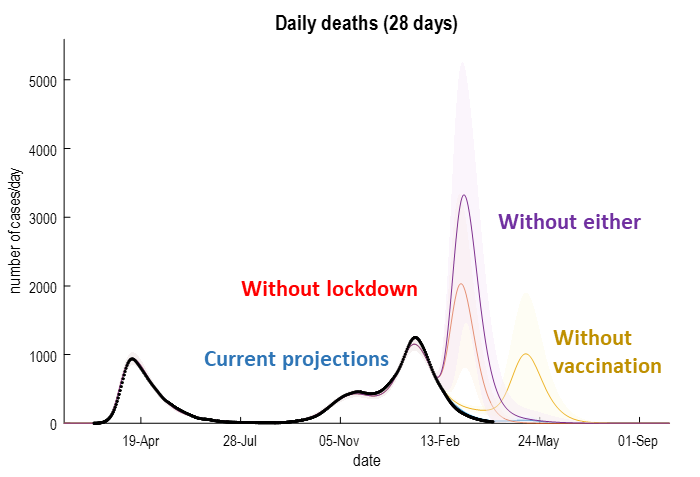Scenario Modelling
Dynamic Causal Modelling, UCL, UK
The Prime Minister said that: "Of course the vaccination programme has helped but the bulk of the work in reducing the disease has been done by the lockdown". Was he right?

It is fairly straightforward to quantify the relative contribution of lockdown and vaccination by predicting what would have happened in the absence of lockdown, in the absence of vaccination rollout and in the absence of both. The above graphic reports estimates based upon the parameters of a dynamic causal model used for nowcasting and long-term forecasting. The lines correspond to expected deaths per day, while the shaded areas correspond to 90% confidence intervals. The blue line is the most likely estimate with both lockdown and vaccination in place, while the black dots correspond to (smoothed) data from the ONS. The remaining three predictions correspond to what might have happened if lockdown had been lifted on 1 Feb 2021 (red), if the vaccination rollout had ceased on 1 Feb 2021 (gold) and if both had been suspended (purple).
It is evident from these projections that a premature lifting of lockdown restrictions would have released a resurgence of fatalities over the past few weeks (peaking at about 2000 deaths per day). Conversely, suspending the rollout of vaccination may have had a less immediate effect but resulted in a wave of fatalities in over the next weeks (roughly the size of the first wave). Removing both lockdown and vaccination produces a worst-case scenario with peak death rates of greater than 3300 per day. In short, lockdown could be claimed to have averted a third (or perhaps fourth) wave over the past few weeks, under the current vaccination rollout. Having said this, lockdown and vaccination clearly work hand-in-hand in precluding resurgences over the next few months.
Other reports and scenario modelling
- Report on risks to children for Independent SAGE (20 May 2020)
- Scenario modelling of the effects of an early (first) lockdown for Channel 4 (30 May 2020)
- Report on unlocking for Independent SAGE (29 Jun 2020)
- Report for parents and teachers for Independent SAGE (5 Sep 2020)
- Scenario modelling of the circuit breaker for UnHerd (8 Oct 2020)
- Report on testing and tracing for Dispatches (3 Nov 2020)
- Appendix on moving between Tiers for advisory group (18 Nov 2020)
- Appendix on testing and tracing for advisory group (18 Nov 2020)
- Report on containment strategy for advisory group (18 Nov 2020)
- Report on Task and Finish Group (SAGE) report (20 Nov 2020)
- Scenario modelling of delaying the third lockdown (28 Dec 2020)
- Scenario modelling of hospital admissions (1 Jan 2021)
- Report on vaccination for Channel 4 News (12 jan 2021)
- Report on SPI-M scenario modelling for the Cabinet Office (24 Feb 2021)
- Report on lockdown versus vaccination (13 Apr 2021)
- Scenario modelling of an early circuit breaker for Channel 4 (13 Apr 2021)
- Scenario modelling of extending the second lockdown for Channel 4 (13 Apr 2021)
- Scenario modelling of lifting the third lockdown for Channel 4 (13 Apr 2021)
- Scenario modelling of lifting of restrictions on 21 June for the Cabinet office (6 Jun 2021)
- Scenario modelling of lifting of restrictions on 21 June for the Cabinet office (7 Jun 2021)
- Scenario modelling of lifting of restrictions on 21 June for the Cabinet office (11 Jun 2021)
- Zero COVID Plus (27 Jun 2021)
- Scenario modelling of lifting of restrictions on 19 July for the Cabinet office (5 July 2021)
- Scenario modelling of childhood vaccination (7 July 2021)
- Scenario modelling of lifting of restrictions on 19 July for the Cabinet office (7 July 2021)
- Scenario modelling of lifting of restrictions on 19 July for the Cabinet office (10 July 2021)
- Scenario modelling of lifting of restrictions on 19 July for the Cabinet office (25 July 2021)
- Scenario modelling of Plan-B for the Cabinet office (30 Oct 2021)
- Scenario modelling of Plan-B for the Cabinet office (13 Jan 2022)
- Scenario modelling of Plan-B for the Cabinet office (17 Jan 2022)
- Scenario modelling for advisory group to the Cabinet Office (16 Mar 2022)
- Scenario modelling self-isolation when symptomatic (16 Mar 2022)
- Comments for i-News (13 Jul 2022)
